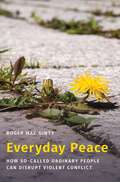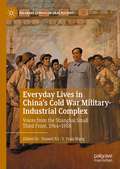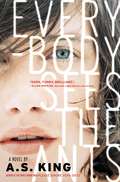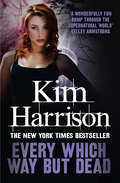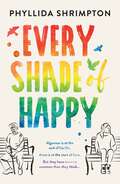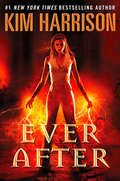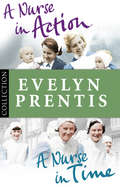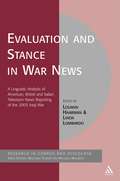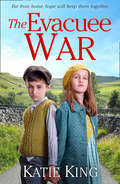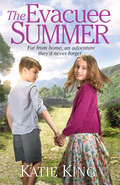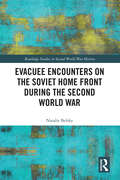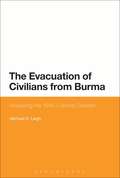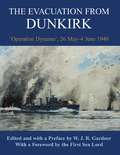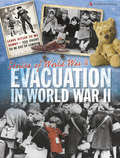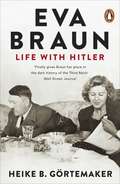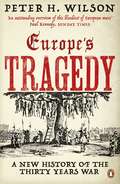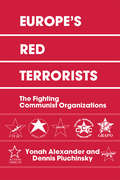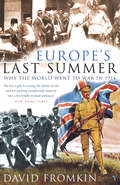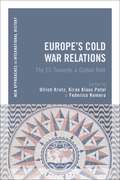- Table View
- List View
Everyday Peace: How So-called Ordinary People Can Disrupt Violent Conflict (Studies in Strategic Peacebuilding)
by Roger Mac GintyAn exploration of how so-called ordinary people can disrupt violent conflict and forge peace. In this pathbreaking book, Roger Mac Ginty explores everyday peace-or how individuals and small groups can eke out spaces of tolerance and conciliation in conflict-ridden societies. Drawing on original material from the Everyday Peace Indicators project, he blends theory and concept-building together with contemporary and comparative examples. Unusual for the disciplines of peace and conflict studies as well as international relations, Everyday Peace also utilizes personal diaries and memoirs from World Wars One and Two. The book unpacks the core components of everyday peace and argues that it is constructed from a mix of sociality, reciprocity, and solidarity. This exploration of bottom-up and community-level approaches to peace challenges the usual concentration on top-down approaches to peace advanced by governments and international organizations. Indeed, the book goes to the lowest level of social organization - individuals, families and small groups of friends and colleagues - and looks at everyday interaction in workplaces, the stairwells of apartment buildings, and the queue for public transport. Mac Ginty sees peace and conflict as being embodied, lived, and experienced - and constructs a multi-layered definition of peace. Importantly, he applies his evidentiary base of micro-acts that constitute everyday peace to societies that have emerged out of conflict and have not experienced recidivism on a large scale. Unlike most who focus on top-down processes, he demonstrates that what matters is the interaction between top-down and bottom-up peace and how, in an ideal scenario, they can have a symbiotic relationship. By focusing on how the small-scale can have big and lasting effects, Everyday Peace will reshape our understanding of how peace comes about.
Everyday Lives in China's Cold War Military-Industrial Complex: Voices from the Shanghai Small Third Front, 1964-1988 (Palgrave Studies in Oral History)
by Youwei Xu Y. Yvon WangThis book translates and contextualizes the recollections of men and women who built, lived, and worked in some of the factory compounds relocated from China’s most cosmopolitan city—Shanghai. Small Third Line factories became oases of relatively prosperous urban life among more impoverished agricultural communities. These accounts, plus the guiding questions, contextual notes, and further readings accompanying them, show how everyday lives fit into the sweeping geopolitical changes in China and the world during the Cold War era. Furthermore, they reveal how the Chinese Communist Party’s military-industrial strategies have shaped China’s economy and society in the post-Mao era. The approachable translations and insight into areas of life rarely covered by political or diplomatic histories like sexuality and popular culture make this book highly accessible for classroom use and the general-interest reader.
Everybody Sees the Ants
by A. S. KingLucky Linderman didn't ask for his life. He didn't ask his grandfather not to come home from the Vietnam War. He didn't ask for a father who never got over it. He didn't ask for a mother who keeps pretending their dysfunctional family is fine. And he didn't ask to be the target of Nader McMillan's relentless bullying, which has finally gone too far. But Lucky has a secret--one that helps him wade through the daily mundane torture of his life. In his dreams, Lucky escapes to the war-ridden jungles of Laos--the prison his grandfather couldn't escape--where Lucky can be a real man, an adventurer, and a hero. It's dangerous and wild, and it's a place where his life just might be worth living. But how long can Lucky keep hiding in his dreams before reality forces its way inside? Michael L. Printz Honor recipient A.S. King's smart, funny and boldly original writing shines in this powerful novel about learning to cope with the shrapnel life throws at you and taking a stand against it.
Every Which Way But Dead (Hollows Ser. #Bk. 3)
by Kim HarrisonFrom New York Times best-selling author, Kim Harrison, comes the third book in her brilliant series, The Hollows; packed with vampires, werewolves and witches - don’t miss out on this sexy urban fantasy.
Every Shade of Happy
by Phyllida ShrimptonHeartwarming and uplifting, Every Shade of Happy will make you laugh, cry and want to call your grandfather. Perfect for fans of Marianne Cronin and Hazel Prior. Algernon is at the end of his life. His granddaughter is at the start of hers. But they have more in common than they think...Every day of Algernon's 97 years has been broken up into an ordered routine. That's how it's been since the war, and he's not about to change now.Until his 15-year-old granddaughter arrives on his doorstep, turning Algernon's black-and-white life upside down. Everything from Anna's clothes to the way she sits glued to her phone is strange to Algernon, and he's not sure he likes it.But as the weeks pass, Algernon is surprised to discover they have something in common after all – Anna is lonely, just like him. Can Algernon change the habits of a lifetime to bring the colour back into Anna's world?Praise for Every Shade of Happy: 'Heartwarming and uplifting. It will make you miss your grandfather and want to hug your grandchild.' Adele Parks for Platinum 'A slice of reading heaven... Just as wonderful and gorgeous as The One Hundred Years of Lenni and Margot and The Funny Thing about Norman Foreman.' LoveReading 'With relatable characters, this is an uplifting, emotive story.' Candis
Every Home Needs A Balcony
by Rina FrankThis international bestseller tells the bittersweet story of one family, one home, and the surprising arc of one woman's life, from the poverty of her youth, to the intense love and painful losses of her adult years.
Ever After (Hollows Ser. #11)
by Kim HarrisonNew York Times bestselling author Kim Harrison returns to the Hollows with the electrifying follow-up to her acclaimed Pale Demon!
Evelyn Prentis Bundle: A Nurse in Time/A Nurse in Action
by Evelyn PrentisDesperate circumstances were something Evelyn Prentis had to get very used to when she began her life as a nurse. It was in 1934 that Evelyn left home for the first time to enrol as a trainee at a busy Nottingham hospital in the hope of £25 a year. A Nurse in Time is Evelyn's affectionate and funny account of those days of dedication and hardship, when never-ending nightshifts, strict Sisters and permanent hunger ruled life, and joy was to be found in a late-night pass and a packet of Woodbines.The second memoir in this collection is A Nurse in Action. Surprising Matron as well as herself, Evelyn Prentis managed to pass her Finals and become a staff-nurse. Encouraged, she took the brave leap of moving from Nottingham to London - brave not least because war was about to break. Not only did the nurses have to cope with stray bombs and influxes of patients from as far away Dunkirk, but there were also RAF men stationed nearby - which caused considerable entertainment and disappointment, and a good number of marriages ...But despite all the disruption to the hospital routine, Evelyn's warm and compelling account of a nurse in action, shows a nurse's life would always revolve around the comforting discomfort of porridge and rissoles, bandages and bedpans.
Evaluation and Stance in War News: A Linguistic Analysis of American, British and Italian television news reporting of the 2003 Iraqi war (Corpus and Discourse)
by Louann Haarman Linda LombardoIn a world in which advanced communication technologies have made the reporting of disasters and conflicts (also in the form of breaking news) a familiar and 'normalised' activity, the information we present here about television news reporting of the 2003 war in Iraq has implications that go beyond this particular conflict. Evaluation and Stance in War News functions as a tool kit for the critical evaluation of language in the news, both as raw data in need of interpretation and as carefully packaged products of 'information management' in need of 'unpacking'. The chapters offer an array of theoretical and empirical instruments for revealing, identifying, sifting, weighing and connecting patterns of language use that construct messages. These messages carry with them world views and value systems that can either create an ever wider divide or serve to build bridges between peoples and countries.
Evaluation and Stance in War News: A Linguistic Analysis of American, British and Italian television news reporting of the 2003 Iraqi war (Corpus and Discourse)
by Linda Lombardo Louann HaarmanIn a world in which advanced communication technologies have made the reporting of disasters and conflicts (also in the form of breaking news) a familiar and 'normalised' activity, the information we present here about television news reporting of the 2003 war in Iraq has implications that go beyond this particular conflict. Evaluation and Stance in War News functions as a tool kit for the critical evaluation of language in the news, both as raw data in need of interpretation and as carefully packaged products of 'information management' in need of 'unpacking'. The chapters offer an array of theoretical and empirical instruments for revealing, identifying, sifting, weighing and connecting patterns of language use that construct messages. These messages carry with them world views and value systems that can either create an ever wider divide or serve to build bridges between peoples and countries.
The Evacuee War
by Katie KingFar from home, hope will keep them together. The plucky evacuees must come together in this heart-warming saga set in the Second World War for fans of Dilly Court and Rosie Goodwin…
The Evacuee Summer
by Katie King‘A heartwarming read’ My Weekly ‘A delightful, nostalgic read’ Woman Magazine Far from home, an adventure they’ll never forget…
Evacuee Encounters on the Soviet Home Front During the Second World War (Routledge Studies in Second World War History)
by Natalie BelskyThis study is the first to examine the experiences of the millions of Soviet civilians evacuated to the interior of the country during the Second World War in the context of their encounters and relations with local communities and populations across Soviet Central Asia, Kazakhstan, Siberia, and the Urals. The book considers the impact of this episode of massive population displacement across Eurasia on individuals, communities, and society more broadly. It explores how the challenges associated with wartime displacement gave rise to tensions between evacuees and local residents. These frictions, in turn, forced individuals to interrogate the meaning, terms, and limitations of citizenship and belonging in the Soviet Union. Evacuation thus played a critical role in the changing relationship between citizens and the Soviet state in the war and postwar periods. Furthermore, this study pays particular attention to the plight of Soviet Jewish evacuees, who constitute the largest contingent of Holocaust survivors in Europe, and the rise of anti-Semitism on the Soviet home front during the war. This volume will be of interest to students and scholars of the Second World War, migration and displacement, the Holocaust, Soviet Jewish history, and the Soviet experience more broadly.
Evacuee Encounters on the Soviet Home Front During the Second World War (Routledge Studies in Second World War History)
by Natalie BelskyThis study is the first to examine the experiences of the millions of Soviet civilians evacuated to the interior of the country during the Second World War in the context of their encounters and relations with local communities and populations across Soviet Central Asia, Kazakhstan, Siberia, and the Urals. The book considers the impact of this episode of massive population displacement across Eurasia on individuals, communities, and society more broadly. It explores how the challenges associated with wartime displacement gave rise to tensions between evacuees and local residents. These frictions, in turn, forced individuals to interrogate the meaning, terms, and limitations of citizenship and belonging in the Soviet Union. Evacuation thus played a critical role in the changing relationship between citizens and the Soviet state in the war and postwar periods. Furthermore, this study pays particular attention to the plight of Soviet Jewish evacuees, who constitute the largest contingent of Holocaust survivors in Europe, and the rise of anti-Semitism on the Soviet home front during the war. This volume will be of interest to students and scholars of the Second World War, migration and displacement, the Holocaust, Soviet Jewish history, and the Soviet experience more broadly.
The Evacuation of Civilians from Burma: Analysing the 1942 Colonial Disaster
by Michael D. LeighThe string of military defeats during 1942 marked the end of British hegemony in Southeast Asia, finally destroying the myth of British imperial invincibility. The Japanese attack on Burma led to a hurried and often poorly organized evacuation of Indian and European civilians from the country. The evacuation was a public humiliation for the British and marked the end of their role in Burma.The Evacuation of Civilians from Burma investigates the social and political background to the evacuation, and the consequences of its failure. Utilizing unpublished letters, diaries, memoirs and official reports, Michael Leigh provides the first comprehensive account of the evacuation, analyzing its source in the structures of colonial society, fractured race relations and in the turbulent politics of colonial Burma.
The Evacuation of Civilians from Burma: Analysing the 1942 Colonial Disaster
by Michael D. LeighThe string of military defeats during 1942 marked the end of British hegemony in Southeast Asia, finally destroying the myth of British imperial invincibility. The Japanese attack on Burma led to a hurried and often poorly organized evacuation of Indian and European civilians from the country. The evacuation was a public humiliation for the British and marked the end of their role in Burma.The Evacuation of Civilians from Burma investigates the social and political background to the evacuation, and the consequences of its failure. Utilizing unpublished letters, diaries, memoirs and official reports, Michael Leigh provides the first comprehensive account of the evacuation, analyzing its source in the structures of colonial society, fractured race relations and in the turbulent politics of colonial Burma.
The Evacuation from Dunkirk: 'Operation Dynamo', 26 May-June 1940 (Naval Staff Histories)
by W.J.R. GardnerThis is the Naval Staff History of "Operation Dynamo", originally published internally in 1949. British ships evacuated nearly 100,000 men of the BEF from the beaches, and over 200,000 from harbours. Other nations' vessels carried more than 30,000.
The Evacuation from Dunkirk: 'Operation Dynamo', 26 May-June 1940 (Naval Staff Histories)
by W.J.R. GardnerThis is the Naval Staff History of "Operation Dynamo", originally published internally in 1949. British ships evacuated nearly 100,000 men of the BEF from the beaches, and over 200,000 from harbours. Other nations' vessels carried more than 30,000.
Evacuation: Evacuation (Stories of World War II #1)
by A.J. StonesCan you imagine leaving your home and your family, and moving hundreds of miles away to live with strangers, because it was too dangerous to stay in your hometown? During World War II, this was situation millions of people, the majority of them children, faced. Stories of World War II: Evacuation tells the stories of these children: where they came from, where they went, who looked after them, what they ate, and how they went to school, along with many other details about their lives as evacuees.Much of the material on which the book is based comes from The National Archives, and so is made up of government documents and reports from during World War II. This gives the book a real grounding in fact and in history - it is a true account of what life was like for evacuees during World War II.The other book in the series, Stories of World War II: Kindertransport, tells the story of Jewish children evacuated to Britain from Germany, Holland and Austria before the outbreak of World War II.
Eva Braun: Life With Hitler
by Heike B. Gortemaker Damion SearlsDAILY TELEGRAPH BOOKS OF THE YEAR and BBC HISTORY MAGAZINE BOOK CLUB title'I want to be a beautiful corpse, I will take poison' Eva Braun, 1945Eva Braun and Adolf Hitler were together for fourteen years, a relationship that ended only with their marriage and double suicide in Berlin. Braun was obsessed with sport, fashion, photography and films, and seems to have had no real interest in politics. She and Hitler were unmarried and they had no children. And so, at the heart of the Nazi regime there was an odd paradox: the leader of a ferocious dictatorship, himself obsessed with imposing an idea of the 'German family' on an entire nation, who chose to spend much of his adult life with a woman 23 years younger than himself in a way that was unideological and bohemian.So who was Eva Braun? Heike Görtemaker's highly praised new book is the first to take Braun's role in the Nazi hierarchy seriously. It uses her to throw fascinating light on a regime that prided itself on its harsh, coherent and unsentimental ideology, but which was in practice a chaos of competing individuals fighting for space around the overwhelmingly dominant figure of Hitler. Braun had a special place 'at court'. She was both marginal and exceptional: a more powerful figure than 'the First Ladies of the Third Reich' such as Magda Goebbels and Margarete Speer, but someone who almost never chose to use that power.Braun's life tells us a huge amount about a particular, catastrophic era in German history, both in her role as Hitler's companion and as the hostess at Nazi social events at the Berghof. Heike Görtemaker's book allows Braun to step out as much as possible from the shadows and fully inhabit her strange role at the heart of a terrible regime.
Europe's Tragedy: A New History of the Thirty Years War
by Peter H. WilsonThe horrific series of conflicts known as the Thirty Years War (1618-48) tore the heart out of Europe, killing perhaps a quarter of all Germans and laying waste to whole areas of Central Europe to such a degree that many towns and regions never recovered. All the major European powers apart from Russia were heavily involved and, while each country started out with rational war aims, the fighting rapidly spiralled out of control, with great battles giving way to marauding bands of starving soldiers spreading plague and murder. The war was both a religious and a political one and it was this tangle of motives that made it impossible to stop. Whether motivated by idealism or cynicism, everyone drawn into the conflict was destroyed by it. At its end a recognizably modern Europe had been created but at a terrible price.Peter Wilson's book is a major work, the first new history of the war in a generation, and a fascinating, brilliantly written attempt to explain a compelling series of events. Wilson's great strength is in allowing the reader to understand the tragedy of mixed motives that allowed rulers to gamble their countries' future with such horrifying results. The principal actors in the drama (Wallenstein, Ferdinand II, Gustavus Adolphus, Richelieu) are all here, but so is the experience of the ordinary soldiers and civilians, desperately trying to stay alive under impossible circumstances.The extraordinary narrative of the war haunted Europe's leaders into the twentieth century (comparisons with 1939-45 were entirely appropriate) and modern Europe cannot be understood without reference to this dreadful conflict.
Europe's Red Terrorists: The Fighting Communist Organizations
by Yonah Alexander Dennis A. PluchinskyThis unique volume explores Europe's most dangerous communist terrorist organizations and reveals how they use violence as a means of political communication and persuasion. It outlines seven terrorist groups from Germany, Greece, Spain, France, Belgium, Italy and Turkey and gives their modus operandi, rationale and political messages in translated communiqués never before available in English.
Europe's Red Terrorists: The Fighting Communist Organizations
by Yonah Alexander Dennis A. PluchinskyThis unique volume explores Europe's most dangerous communist terrorist organizations and reveals how they use violence as a means of political communication and persuasion. It outlines seven terrorist groups from Germany, Greece, Spain, France, Belgium, Italy and Turkey and gives their modus operandi, rationale and political messages in translated communiqués never before available in English.
Europe's Last Summer: Who Started The Great War In 1914?
by David FromkinThe Great War not only destroyed the lives of over twenty million soldiers and civilians, it also ushered in a century of huge political and social upheaval, led directly to the Second World War and altered for ever the mechanisms of governments. And yet its causes, both long term and immediate, have continued to be shrouded in mystery. In Europe's Last Summer, David Fromkin reveals a new pattern in the happenings of that fateful July and August, which leads in unexpected directions. Rather than one war, starting with the assassination of Archduke Franz Ferdinand, he sees two conflicts, related but not inseparably linked, whose management drew Europe and the world into what The Economist described as early as 1914 as 'perhaps the greatest tragedy in human history'.
Europe's Cold War Relations: The EC Towards a Global Role (New Approaches to International History)
by Ulrich Krotz Kiran Klaus Patel Federico RomeroThis thought-provoking collection analyses the European Community's external relations between 1957 and 1992, with a particular focus upon their broader impact and global significance. Reconceptualizing the long arc of the EC's international role, from its inception in the 1950s to the end of the Cold War, the chapters identify and assess the factors that either supported or impeded Europe's international projection within this period.Organized into three parts, the authors investigate the EC's relations with key countries and world regions, discuss its activities within key policy areas, and offer reflections and conclusions on the various arguments that are put forward. Each chapter considers the entire period from 1957-1992 to identify and explain overarching trends, key decisions and historical conjunctions through scholarly literature, key debates and original discussion of each topic or policy issue. A final chapter situates the main findings within wider contexts, situating the EC in Cold War history. Bringing together international history and international relations, this project allows for cross-disciplinary dialogue and the careful discussion of key concepts, analytical approaches, and empirical findings. Filling a gap in our understanding of the early development of the EC's role as an autonomous global actor, this book holds important messages for the modern day, as the EU's position in global politics continues to shape the world.
